
Website founded by
Milan Velimirović
in 2006
23:13 UTC


| |
MatPlus.Net  Forum Forum  Competitions Competitions  Chess Problems & Studies Discord Composition Tournament #1 Chess Problems & Studies Discord Composition Tournament #1 |
| |
|
|
|
|
You can only view this page!
| | | (1) Posted by edderiofer [Wednesday, Apr 14, 2021 15:05] | Chess Problems & Studies Discord Composition Tournament #1
Welcome, everyone, to Chess Problems & Studies Discord Composition Tournament #1! As this is our Tournament #1, it seems only fitting that it should be a tournament for #1 problems; i.e. the stipulation should be "White mates in one". This tournament is in part inspired by the famous "difficult mate-in-one" allegedly by Leonid Kubbel (YACPDB #523135) ("allegedly" since I can't find where it was originally published). THIS IS AN INFORMAL TOURNAMENT FOR WHICH THERE IS NO PRIZE.
(Link to the Discord: http://discord.me/chessproblems)
TL;DR: You have two weeks to compose up to five orthodox onemovers with White to move, which will then be ranked by popular vote. Send all submissions to @edderiofer#0713 or to [username]@gmail.com. Detailed rules below.
---
1. This tournament is organized by edderiofer.
2. There will be only one division: orthodox directmates in one with White to move.
3. The following conditions apply (many of these conditions will already be familiar to regular tournament-participants):
* Entries should consist of the board position and the intended solution in algebraic notation.
* The problem must be composed by the submitter and not be previously published. Anticipated problems (i.e. submissions that have a similar position to a previously-published problem) may be disqualified at the organiser's discretion.
* The problem must be sound. This is defined in the Codex of Chess Composition, but here essentially means that the solution given by the composer is the only way to mate in one. This will be checked with whatever version of Olive is newest during the verification-and-amendments period. (Participants are advised to computer-check the soundness of their own problems before submission.)
* The position should be legal with White to move. (In particularly difficult-to-determine cases, including positions where the solution/soundness hinges on the legality of the position, you may be asked by the organiser to provide a proof game.)
* Promoted pieces on the board are allowed.
4. There is a maximum of five entries per composer. (In the event that more than five entries are submitted and the composer does not specify which ones they wish to enter, only the last five entries submitted will be eligible for ranking and the rest will be disqualified.)
5. Please send all entries via Discord DMs to @edderiofer#0713, or via email to [username]@gmail.com.
6. The submission phase will run for two weeks from the date of this message (i.e. until 2021-04-28, 13:00 UTC). After this, there will be a small delay for the purposes of verification and amendments to any submissions.
7. After the small delay for verification and amendments, all problems will be published, anonymously, on the server and on MatPlus. Judging will be done by popular vote by the community. Server and MatPlus members have two weeks to privately vote on which problems they think are the best. (Send your votes via Discord DMs to @edderiofer#0713, or via email to [username]@gmail.com.)
7a. The voting system we will use is a modified form of Approval Voting. Voters may vote for any number of problems they like; each such problem will gain 1 vote. Composers may not vote for their own problems, but may still vote for other peoples' problems; each such vote will give the voted-for problems 1 vote each and each of their own problems 1/n votes (where n is the number of problems that composer is allowed to vote for). At the end of the voting period, the person with the most votes wins. Some consequences of this (which you may wish to note) are:
* Voting for everyone you can vote for is equivalent to not-voting, whether you are a composer or not.
* If two composers receive the same number of normal votes, the person who has voted for more problems will generally have a higher score. This still incentivises composers to vote for other composers' problems.
* A composer's votes are worth slightly more to them if they submit more problems.
8. After the voting period, there will be a short delay while votes are tallied before the lists of who-voted-for-who and composers of problems are announced. All eligible submissions will receive a ranking. There will thus be no Honourable Mentions.
9. Due to the lack of attribution during the voting period, server members and MatPlus readers should NOT share submissions outside the server or MatPlus until after the results and attributions are announced.
10. Disqualified submissions (e.g. on the grounds of unsoundness, unoriginality, or other reasons for ineligibility) will not be published (but will be counted in the writeup).
---
If you have any questions about the rules, feel free to ask them in this thread or send me a message.
---
Rule clarifications:
* In the case of a promotion being the solution, duals are allowed if the solutions are queen/rook promotions or queen/bishop promotions. (This decision, while not entirely fitting with the Codex, is to make things slightly easier for less-experienced constructors. Of course, be aware that if your submission does do this, it might receive fewer votes.)
* Problems may require retroanalysis to determine legality of en passant or castling.
* Orthodox problems only. No fairy pieces, conditions, odd boardshapes/sizes, "correct the position/rotate the board/complete this half of a move first", or other tricks of this type allowed. (Chess960 counts as a fairy condition here.)
* Twinning is allowed (but don't abuse this to submit wildly different problems as "one single submission").
* If multiple composers collaborate on one puzzle, they are considered a team. Each team may send only one composer to vote, according to the rules above.
---
For reference, here's the "difficult mate in one" mentioned:
Leonid Kubbel?
Source?
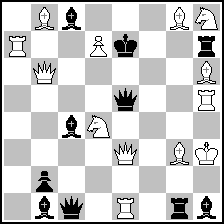 (= 13+10 ) (= 13+10 )
| | | (2) Posted by Sarah Hornecker [Thursday, Apr 15, 2021 18:22] |
EDIT: Oops, the original post was updated to include what he told me in private, that twinning is allowed.
EDIT 2: The Kubbel problem has 18 different* checks that fail to deliver checkmate.
* Promotions count as the same check if the promoted piece itself is not important, so taking on c8 counts as two and not as four different checks.
I also seem unable to find the source for Kubbel's problem. But Kubbel did quite a few unusual problems, so did he ever write a collection of them (possibly in an article, not necessarily in a book)?
| | | (3) Posted by edderiofer [Thursday, Apr 22, 2021 13:59] |
There are only six days left to enter Composition Tournament #1. If you've already constructed some entries, send them in soon or they won't count!
| | | (4) Posted by Joost de Heer [Thursday, Apr 22, 2021 22:11] |
Oops. I sent a #1 but overlooked the 'only orthodox compositions are allowed'.
 (= 1+1+4N ) (= 1+1+4N )
#1 Atom chess, Mirror circe, Glasgow chess
| | | (5) Posted by Sarah Hornecker [Friday, Apr 23, 2021 16:31] |
Joost, that could have won a prize in any tourney.
| | | (6) Posted by Joost de Heer [Sunday, Apr 25, 2021 12:05] |
I doubt it. There are so many neutral AUWs nowadays that it's no longer special. It's not even the first one in 1 move, I published one several years ago (although I can't remember the position anymore, and it's not in any of the databases, it used the same conditions, but with additional Madrasi to motivate the knight promotion).
| | | (7) Posted by Joost de Heer [Sunday, Apr 25, 2021 12:24] |
-
| | | (8) Posted by edderiofer [Wednesday, Apr 28, 2021 15:08] |
Submissions are now closed. I'll randomise/anonymize and post the entries for voting, hopefully in the next few days.
I received at least one entry that was a collaboration between multiple authors. I think that in order to be fair, each such collaborating team should have only one person from their team vote. I'll update the rules to reflect this and be more clear about this in the future.
| | | (9) Posted by edderiofer [Sunday, May 2, 2021 15:04] |
OK, below are the entries for Composition Tournament #1, anonymised, presented in a randomised order, and labelled with letters from A to W! (Mottos, solutions, and author comments are given in "highlight-to-view" spoilers.)
You have two weeks from the date and time of this message (2021-05-16 13:00 UTC) to vote on which entries you think are best; send your votes in to [username]@gmail.com or @edderiofer#0713 on Discord. As a reminder, we are using a modified form of Approval Voting (vote for as many entries as you like) where entrants may vote on other entries and gain partial votes for their own entries by doing so.
---
A: 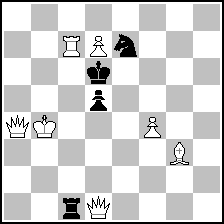 (= 7+4 ) (= 7+4 )
#1
Solution: f4-f5#
B:  (= 14+5 ) (= 14+5 )
#1, b) Move f5 -> e1, c) Move f5 -> g1
Solutions: a) d5xe6 e.p.#, b) O-O#, c) f7-f8=Q/R#
Author comments: Valladao. Retroanalysis for a): White is only missing two pieces: The black-squared bishop and the queen. The bishop never left c1, and the queen must have been captured on a6 before the bishop went to a8. This means Black’s last move can not have been a capture. Black’s king can not have made the last move, and the pawn can not have come from e6, so the last move must have been e7-e5.
C: 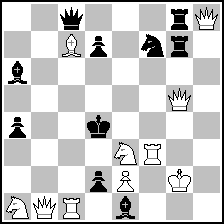 (= 10+10 ) (= 10+10 )
#1
Solution: Qg5-g4#
D: 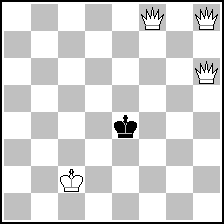 (= 4+1 ) (= 4+1 )
#1
Solution: Qh6-e6#
E: 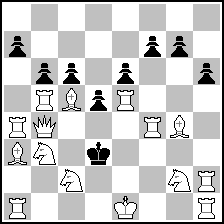 (= 15+9 ) (= 15+9 )
#1
Solution: Qb4-d2#
Author comments: [Reproduced at this link due to length: https://docs.google.com/document/d/1H7lPSzm6uszcfJtKpTjbttuOCgfUOGY845PiVu-ZK8Q/edit?usp=sharing]
F: 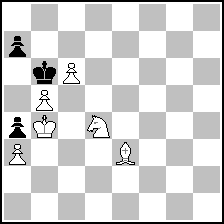 (= 6+3 ) (= 6+3 )
#1
Solution: Nd4-e6#
G:  (= 4+1 ) (= 4+1 )
#1
Solution: Bd4-e3#
H:  (= 10+6 ) (= 10+6 )
#1
Motto: "Broken record"
Solution: Qe1xa1#
Author comments: The five bBs cut down the 92 mates-in-one that would otherwise be available (albeit in an illegal (but easy to legalize) position), to just one.
I:  (= 12+10 ) (= 12+10 )
#1
Solution: Qe3-b6#
J:  (= 8+7 ) (= 8+7 )
#1
Solution: Ne5-g4#
Author comments: Tries: 1.Ng6+? Ke4 / 1.Nf7+? e5 / 1.Nd7+? Be5 / 1.Nxc6+? Kxc6 / 1.Nxc4+? Kxc4 / 1.Nd3+? Nf5 / 1.Nf3+? Rg5
K: 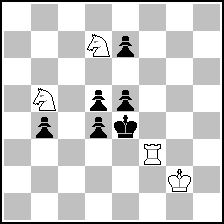 (= 4+6 ) (= 4+6 )
#1, b) rotate 90° CW, c) rotate 180°, d) rotate 270°
Solutions: a) Nd7-c5#, b) Ne7-f5#, c) Ng4-f6#, d) Nb4-c6#
Author comments: Four asymmetrical solutions. Four different knight mates (on c5 d6 c3 f6 when viewed from the diagram position).
L:  (= 15+11 ) (= 15+11 )
#1
Solution: Rf4xc4#
M:  (= 12+12 ) (= 12+12 )
#1 (& SPG in 8.0)
Solution: Qd1-h5#
Author comments: C+ Natch 3.2 (& no shorter solutions)
1. h4 Sc6 2. h5 Sd4 3. h6 Sxe2 4. hxg7 Sg3 5. gxh8=S Sxh1 6. Sxf7 Sxf2 7. Kxf2 Kxf7 8. Ke1 Ke8
& C+ Popeye for the #1! :)
Homebase + Prentos S promotion + echoed King switchbacks KxSf2 KxSf7
N:  (= 9+5 ) (= 9+5 )
#1, b) move b8 -> c8, c) move b8 -> g5
Solutions: a) Nb8-d7#, b) Rc6-c5#, c) f3-f4#
O:  (= 5+7 ) (= 5+7 )
#1
Motto: ""Just Underpromote", The Composition"
Solution: c7-c8=N#
P:  (= 5+2 ) (= 5+2 )
#1
Motto: "Homebase"
Solution: Qd1-h5#
Q: 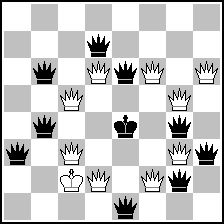 (= 10+10 ) (= 10+10 )
#1
Solution: Qd2-d3#
R:  (= 9+8 ) (= 9+8 )
#1
Solution: b5xc6 e.p.#
Author comments: 1.fxe6 e.p.#? is illegal. Black’s last move can only have been …c7-c5 or …e7-e5. White’s pawns have made 8 captures, which means they captured all of Black’s missing pieces. This includes the dark-squared bishop, which must have moved from f8 in order to be captured by a White pawn. This means the pawn on e7 must have moved or been captured earlier, so Black’s last move can not have been …e7-e5. This leaves …c7-c5 as the only possible last move.
S:  (= 2+6 ) (= 2+6 )
#1 duplex
Solutions: w) Qf6-a1#, b) Qf8-a8#
Author comments: Asymmetrical solutions.
T:  (= 6+6 ) (= 6+6 )
#1
Solution: Qh4-f4#
U:  (= 14+6 ) (= 14+6 )
#1
Solution: Qc1-h6#
V: 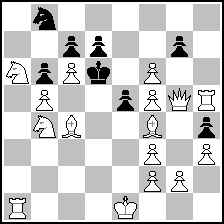 (= 16+8 ) (= 16+8 )
#1
Motto: "En Passan't"
Solution: Ra1-d1#
Author comments: The fact that white had to move to let the h1 rook out easily rules out 0-0-0, but what about en passant? If you count captures, it turns out in fact that white has made 8 pawn captures, and retracting e7-e5 makes it so the f8 bishop couldn't have left its home square. This means the last black move was e6-e5 as the only possibility.
W: 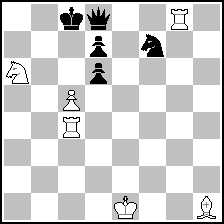 (= 6+5 ) (= 6+5 )
#1
Solution: c5xd6#
| | | (10) Posted by edderiofer [Sunday, May 9, 2021 15:00] |
Just one more week to vote on Composition Tournament #1! If you haven't voted already, please remember to vote!
| | | (11) Posted by edderiofer [Thursday, May 20, 2021 12:42] |
The results are in! First off, some stats:
* A total of 11 authors contributed 23 eligible problems to this tournament. Only one entrant, Marken Foo, submitted the maximum of five problems.
* Nine problems were ineligible for judging. Most of these were either because the position given was not legal with White to move, or because en passant was not provable; two submissions were received late, and one did not give the full board position.
* Five problems received no votes at all (other than partial votes from the authors voting for other people).
I think this one's been a success. Thoughts on this format:
* I chose this voting system because it's been tried and tested in a different server of mine. I think I'll stick with it, as it seems to be getting good reception (even if it's a little confusing).
* I think two weeks for the voting period might be a bit long; all votes I received were received in the first week of the voting period. Perhaps I should change the format to be 2 weeks of construction and one week of voting, to give me a week to prep for each tournament? Do give me your thoughts on this.
* Likewise, I wonder if five entries per author is a bit much? I might run out of letters to represent these problems.
* I'm not making who-voted-for-who public for this one, but should I make that public for the next one?
* Theme-wise, I tried to pick a theme that wasn't very well-explored, but which wouldn't be too much of a hurdle to first-time composers or absolute newcomers to the art. However, it looks like the only entrants into this tournament were people who had previously entered Tournament #0, or other tournaments elsewhere, and the more-experienced problemists took home most of the votes. I suppose this is understandable, though, given that the server's growth this month wasn't as large as I'd have liked. I think it's still best that I stick to this kind of theme, though, as the Discord grows to introduce newcomers to chess problems.
* While I did state that the inspiration was Kubbel's(?) "hardest mate in one", there was of course no requirement for submissions to be in the same spirit, and quite a few submissions instead went for some technical feat/other theme rather than a difficult mate-in-one.
* One complaint I did get was that this was a mate-in-one tourney, not a retro tourney. In hindsight, maybe I should have split this into two divisions; one for retroanalysis-requiring problems, and one for problems that didn't require retroanalysis; instead of lumping the two together. Well, lesson learned for next time, I suppose. (This is an informal tournament, so hopefully nobody's angry about this.)
* This is a community-run tournament. If you have an idea for a theme you think suits the "not very well-explored, not too much of a hurdle to first-time composers" criteria, and you're willing to take on the burden of running a tournament, let me know and I'll put you on the list of future tournament organisers (since I'd probably wish to enter myself to practice my composing skills, you might not wish to tell me what the theme is).
---
Without further ado, then, the results (votes are rounded to the nearest 0.01) with some comments by me:
In first place, entry J, composed by Geir Sune Tallaksen Østmoe, with 6.25 votes. A knight-wheel with four initially-pinned pieces being unpinned in four variations. With four unpins and a discovered check, this does necessitate a promoted piece of some sort, so this problem would likely only have been submittable to this competition (which specifically allowed for promoted pieces in the diagram). Well done!
Tied for third place, entries K and H, both by Adrian Storisteanu, each receiving 6.1 votes. "rotate the board" problems like entry K are always fun, though the fact that there's a symmetry around the a8-h1 diagonal means that we have two pairs of twins that are mirror images of one another. Entry H, meanwhile, is about as "hard", technically, as it gets; a whopping 77 non-mating checks (though I haven't yet checked how many of those leave only one Black response). The aesthetic layout of the white queens is also pretty cool here.
In fourth place, entry B, composed by Geir Sune Tallaksen Østmoe, with 5.25 votes. A triplet Valladao in a mate-in-one, moving just the king. Lovely!
In fifth place, entry E, by Andrew Buchanan and Guus Rol, with 4.43 votes; a retroanalysis Cantcastler requiring the solver to deduce the order of various pawn captures and avoiding retro-loops to finally rule out the possibility of O-O-O. Whoof. Thank goodness I didn't have to actually judge this one on a tight time limit.
In sixth place, entry V, by Silverbyte, with 4.29 votes. It's usually assumed, unless provable otherwise, that White cannot capture en passant. Here, though, White is provably *unable* to capture en passant, and is also provably unable to castle. One voter said "If only there was a promotion try too!".
In seventh place, entry P, by Marken Foo, with 4.28 votes (yes, the difference between this one and the previous one was less than 0.01 votes!). A "Homebase" (actually a home-and-away-base) theme. I think there's something to be said about the simplicity of the position, but I'm not sure what I'd say.
In eighth place, entry S, by Adrian Storisteanu, with 4.1 votes. The constraint "the position must be legal with White to move" that I specified was intended to stop people from submitting problems where retroanalysis shows that it's Black to move (or where the board is loaded with more material than possible). Duplex is a cheeky way of getting around that. Combined with the symmetry in the position and the symmetry in the solutions being different, I quite like this problem.
In ninth place, entry C, by Marken Foo, with 3.28 votes. This one was one of the ones that best kept to the inspiration of "hardest mate in one". There are quite a few tries here that an unsuspecting chess player might go for, like Nc2+? (Kc4!), Qh4+? (Qxh4!), and Bb6+? (Qc5!). Qf4+ and Qh4+ are prohibited by the pinning g7-rook, of course.
In tenth place, entry R, by Geir Sune Tallaksen Østmoe, with 3.25 votes. A "which en passant?" problem. This is arguably anticipated by YACPDB 32775 (Thomas Rayner Dawson), but the matrix was different enough that I wasn't too fussed about it. Evidently enough people liked it, anyway.
In 11th place, entry L, by Ethan Donaghue, with 3.23 votes. Like entry C, this one tried to be another "hardest mate in one". They've reused the idea of a pinned pawn being unable to promote with mate, but the mating idea is quite different; in Kubbel's(?) problem, we have a queen that's already pinned from the start; here, we additionally have a discovered check that further pins another piece.
Tied for 13th place, entries T and I, by Marken Foo, both with 2.28 votes. Entry T has five queens per side, two of which are pinned; the solution is of course valid because of such a pin. Entry I is another "hardest mate in one" that feels quite similar to Kubbel's(?) problem (once again we have a White queen giving mate, while "discovering" a pin on the Black queen via a rook behind it), but perhaps there's only so many variations one can make with such problems. Thank goodness this tournament wasn't *just* about making the hardest mate-in-one.
In 14th place, entry Q, by James Malcom, with 2 votes. Nine queens per side, this time, the absolute maximum on the board! Eight of White's queens form a circle around Black's king, too. Hmm, if that queen on h6 had been on h2 instead, this would have been apt for entry Q, wouldn't it?
In 15th place, entry M, by Andrew Buchanan, with 1.43 votes. A homebase #1 that's also an SPG 8.0! A neat concept that I probably would have voted for despite its #1 content being perhaps a little lacking.
In 16th place, entry U, by Silverbyte, with 1.29 votes. Another "hardest mate in one", although this time Black has substantially less material. Still, Black is somehow able to fend off many of White's responses. The three pawns at the top, about to promote, look especially tantalising, yet we can't promote to a Dabbaba because this is orthodox chess!
In 17th place, entry N, by Siegfried Hornecker, with 1.18 votes. A simple triplet mate-in-one. Those pieces lined up on the a1-h8 diagonal are pretty funny, and I do like how the knight, after being moved, is able to relieve other pieces of their duty, allowing them to give the mate instead. Hmm, I wonder if some small alteration to the position could allow for a fourth twin in this one? I personally think this should have placed higher, but I guess maybe my aesthetic sense for chess problems isn't what other people are looking for.
In 18th place, entry W, by LilHamood, with 1 vote. I mean, this is a mate in one, but it doesn't really feel like a particularly noteworthy mate in one. This feels like a tactical training puzzle rather than a chess problem. Maybe it could form the basis for a longer problem?
Tied for 20th place, entries A and G, by alshfik, with 0.81 votes each. Entry A looks like it might have been an attempt at making a mate-in-one with many tries, but it's quite bare compared with entries C, L and I. Entry G is a miniature, but I don't think it's particularly noteworthy? As with entry W, it could probably form the basis for a longer problem.
In 21st place, entry D, by Marken Foo, with 0.28 votes. The three queens in the corner and the slight asymmetry to the position is cute, but as with the previous three problems, it doesn't really feel quite as meaty as the competition and could perhaps form the basis for a longer problem. Still, with three queens, finding mate in one can definitely be a challenge.
Tied for 23rd place, entries O and F, by LilHamood, with 0 votes each. I find it quite amusing how Black is so hemmed-in in entry O, but I feel like the author could have moved the matrix about so that Black's king starts off with absolutely no breathing room whatsoever, and added more white pieces for more tries. Like with entries W, A, G, and D, entry F is also the sort of position that could form the basis for a longer problem; it's quite bare as-is.
As a summary, here are the rankings again in an image (how do I embed this?): https://i.imgur.com/UqIATBU.png
| | | (12) Posted by seetharaman kalyan [Thursday, May 20, 2021 13:55] |
If nine problems were ineligible how there are 23 placings?
| | | (13) Posted by edderiofer [Thursday, May 20, 2021 15:21] |
The 23 placings are from the 23 eligible problems. The nine ineligible problems were not published for voting. The post above has been edited to better reflect this.
| | | (14) Posted by Joost de Heer [Thursday, May 20, 2021 15:54] |
R is IMO too close to the Dawson christmas tree to be original.
| | | (15) Posted by Hauke Reddmann [Thursday, May 20, 2021 16:24] |
I didn't vote, but interestingly I would have chosen D,
for the high difficulty/material ratio (I'm a lightning fast
twomover solver, and it stumped me for a minute).
De gustibus etc.
| | | (16) Posted by Joost de Heer [Thursday, May 27, 2021 14:56] |
QUOTE
I published one several years ago (although I can't remember the position anymore,
https://pdb.dieschwalbe.de/P1315597
| | | (17) Posted by Andrew Buchanan [Thursday, Jun 3, 2021 02:19] |
Given there are going to be a number of Discord Composition Tourneys, is it possible for the title string to include the identifier (here "#1") nearer the beginning, so it is readable in the list of threads, please? Thanks!
| | | (18) Posted by edderiofer [Sunday, Jun 6, 2021 08:31] |
Sure, I think in the future I'll abbreviate the title to "Discord Composition Tournament" or perhaps "CP&SDCT".
| | | (19) Posted by Sarah Hornecker [Sunday, Jun 6, 2021 08:52] |
Please don't use that second abbreviation. The abbreviation "CP" has very bad implications in western countries.
| | | (20) Posted by Joost de Heer [Sunday, Jun 6, 2021 10:56] |
I probably live in the wrong Western country then, for me cp is just a Unix command.
| |
No more posts |
MatPlus.Net  Forum Forum  Competitions Competitions  Chess Problems & Studies Discord Composition Tournament #1 Chess Problems & Studies Discord Composition Tournament #1 |
|
|
|
 ISC 2024
ISC 2024 Forum
Forum  Competitions
Competitions  Chess Problems & Studies Discord Composition Tournament #1
Chess Problems & Studies Discord Composition Tournament #1 


